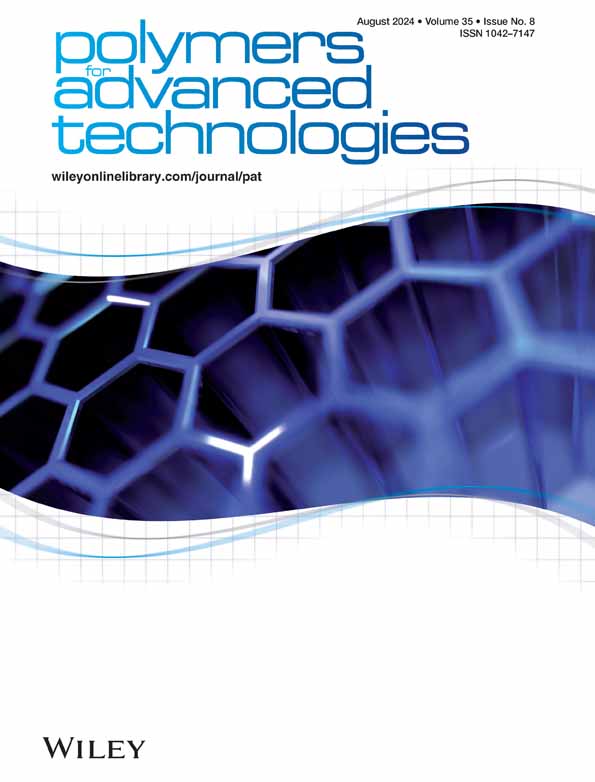紫外线固化技术加化学镀铜:生产高耐用织物基柔性电路的新方法
IF 3.4
4区 工程技术
Q2 POLYMER SCIENCE
引用次数: 0
摘要
柔性电路的构建是设计和制造基于织物的柔性电子器件的一个关键和具有挑战性的方面,这种电子器件在各种应用中具有巨大的潜力。在这项研究中,我们巧妙地将紫外线固化技术与化学镀技术相结合,成功地开发出了高精度、耐用的织物柔性电路。具体来说,首先在聚酯纤维织物表面涂上含有 Ag/Fe3O4 催化剂的紫外涂层,然后利用紫外光引导涂层固化,将设计好的电路结构图打印到织物上,再通过化学镀工艺制造出织物基柔性电路。织物柔性电路在耐久性测试(包括弯曲(8000 次)、磨损(2000 次)、高低温稳定性(-30 至 60°C)和高温/湿度稳定性(65°C,相对湿度 = 95%,48 小时))后,仅表现出极小的电阻增加,且始终保持稳定。这项技术的开发为智能可穿戴设备的各种应用带来了巨大潜力。本文章由计算机程序翻译,如有差异,请以英文原文为准。
Ultraviolet curing technology plus chemical copper plating: A novel method for producing highly durable fabric‐based flexible circuit
The construction of flexible circuits is a crucial and challenging aspect in the design and fabrication of fabric‐based flexible electronics, which hold significant potential for various applications. In this study, we successfully developed high‐precision and durable fabric‐based flexible circuits by ingeniously combining ultraviolet light (UV)‐curing technology with chemical plating. Specifically, a UV coating containing Ag/Fe3 O4 catalysts was applied onto polyester fabric surface, followed by printing the designed circuit structure diagram onto the fabric using UV light‐directed curing of the coating, and fabric‐based flexible circuits were then fabricated through chemical plating process. The fabric‐based flexible circuits exhibit only minimal increases in resistance following durability testing, including bending (8000 times), abrasion (2000 times), high and low temperature stability (−30 to 60°C), and high temperature/humidity stability (65°C, RH = 95%, 48 h), which remains consistently stable. This developed technology holds immense potential across various applications for smart wearable devices.
求助全文
通过发布文献求助,成功后即可免费获取论文全文。
去求助
来源期刊

Polymers for Advanced Technologies
工程技术-高分子科学
CiteScore
6.20
自引率
5.90%
发文量
337
审稿时长
2.1 months
期刊介绍:
Polymers for Advanced Technologies is published in response to recent significant changes in the patterns of materials research and development. Worldwide attention has been focused on the critical importance of materials in the creation of new devices and systems. It is now recognized that materials are often the limiting factor in bringing a new technical concept to fruition and that polymers are often the materials of choice in these demanding applications. A significant portion of the polymer research ongoing in the world is directly or indirectly related to the solution of complex, interdisciplinary problems whose successful resolution is necessary for achievement of broad system objectives.
Polymers for Advanced Technologies is focused to the interest of scientists and engineers from academia and industry who are participating in these new areas of polymer research and development. It is the intent of this journal to impact the polymer related advanced technologies to meet the challenge of the twenty-first century.
Polymers for Advanced Technologies aims at encouraging innovation, invention, imagination and creativity by providing a broad interdisciplinary platform for the presentation of new research and development concepts, theories and results which reflect the changing image and pace of modern polymer science and technology.
Polymers for Advanced Technologies aims at becoming the central organ of the new multi-disciplinary polymer oriented materials science of the highest scientific standards. It will publish original research papers on finished studies; communications limited to five typewritten pages plus three illustrations, containing experimental details; review articles of up to 40 pages; letters to the editor and book reviews. Review articles will normally be published by invitation. The Editor-in-Chief welcomes suggestions for reviews.
 求助内容:
求助内容: 应助结果提醒方式:
应助结果提醒方式:


